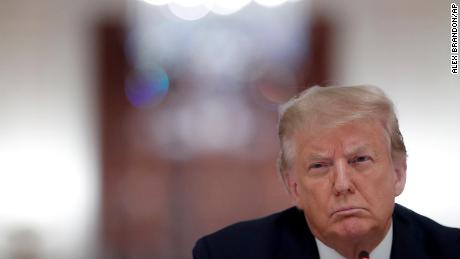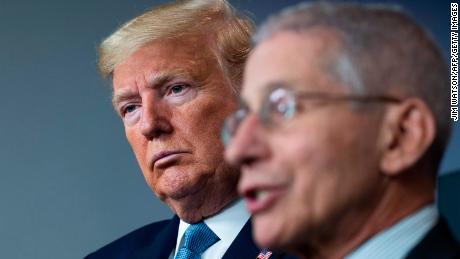The President’s failure to ask the nation to make sacrifices that could quell the virus are consigning the US to a worsening pandemic with no route to health
Within hours, Vice President Mike Pence, the head of the White House coronavirus task force, said the CDC would issue new guidelines.
“The President said today we just don’t want the guidance to be too tough, and that’s the reason why, next week, the CDC’s going to be issuing a new set of tools, five different documents that will be giving even more clarity on the guidance going forward,” Pence told reporters.
The responses of the vice president and other top officials at a relentlessly upbeat White House task force briefing, which glaringly clashed with the reality of a new daily record of 60,000 new cases of the virus, underscored how the government is geared more toward appeasing an unbending President than giving an honest accounting of the crisis and taking steps that could defeat it.
Dr. Robert Redfield, who leads the CDC and walks a constant tightrope, often unsuccessfully under fierce pressure from Trump, emphasized that the new guidelines should in no way slow Trump’s push to reopen all schools within weeks.
“I want to make it very clear that what is not the intent of CDC’s guidelines is to be used as a rationale to keep schools closed,” Redfield said, pledging to work with schools and officials to propose optimum and safe opening plans.
“It would be personally very disappointing to me, and, I know, my agency, if we saw that individuals were using these guidelines as a rationale for not reopening our schools.”
His comments came a day after Trump demanded that all schools reopen in the fall, then the President waffled when asked how that could be safely achieved given worsening conditions.
And they begged this question: What is the point of CDC guidelines if the conditions are either so lax that they are largely meaningless or cannot be used as a reason to keep schools closed if basic safety recommendations are not met?
The plight of America’s children
Alongside the hardship of millions of Americans thrown out of work by shutdowns introduced to stem the spread of the virus, the need to get kids back to school may be the most important task facing the government. The prospect of the loss of critical years of learning, coupled with the psychological and emotional effects of being stuck at home, is having a painful effect on the nation’s children.
And parents cannot commit to returning to work, in many cases, before their children can go back to class, further hampering hopes of an economic rebound.
Yet no one in authority has yet explained how the full-time schooling that Trump has demanded is possible given the need for social distancing in crammed school buildings and the risk to teachers, who are far more prone to Covid-19 complications than their students.
The President — who appears to feel no obligation to lead other than in delivering aggressive soundbites — is also ignoring the fact that kids can carry the virus home to more vulnerable parents and grandparents, a factor that could cause new outbreaks of disease in the fall.
Dr. Ashish Jha, faculty director at Harvard’s Global Health Institute, warned that the CDC guidelines were already the minimum requirement to open schools and warned of a long-term educational disaster if the openings were not properly planned.
“I think the CDC’s recommendations are really basic and, in fact, I think they should go further. Look, you can open up schools anywhere you want. That’s really not the debate,” Jha said on CNN’s “The Lead.” “The question is can you keep schools open? Can you prevent massive outbreaks among teachers and staff and kids? And if we don’t do the things the CDC is asking for, and more, the schools will all be shut by Columbus Day and they will be shut for long periods of time. That’s what we have to avoid, and we’re not. We can’t bluff our way through this; we’ve got to let science drive it.”
Schools controversy recalls Trump’s demands to open states
The building controversy over the CDC’s school-closing guidelines is beginning to recall the health agency’s guidelines drawn up this spring to ensure a safe opening of state economies — which were later ignored by many governors at the urging of a President desperate to revive his reelection hopes.
It is also a reminder of Trump’s position on the wearing of masks, weeks after he announced new CDC guidelines asking Americans to wear face coverings in public places where they could not social-distance — then immediately undercut the advice by saying he himself would not do so.
Pence’s swift accommodation of Trump’s complaints on Wednesday was notable, because the President did not provide any logical or scientific arguments for his opposition to CDC guidelines. He just said the agency was asking schools to do “impractical things” — steps that no doubt would contradict his demand for schools to open come what may.
Another key member of the task force, Dr. Deborah Birx, did attend. She said she saw “encouraging” signs in hot-spot states such as Florida, Texas and Arizona, for instance citing a dip in positivity rates in testing results. But Birx added that states running into trouble should go back to phase one of their opening plans, a statement that puts her at odds with Trump’s warnings that America must continue to open the economy.
CDC officials have told CNN in recent months that they feel “muzzled” as their advice has been disregarded by a White House that is more concerned about the President’s political requirements than a coordinated effort to curtail the virus.
White House denies disconnect with the CDC
Despite the obvious clashes between the President and his health experts, White House press secretary Kayleigh McEnany denied there was any tension between Trump and the CDC.
“I would note that the CDC is very much on the same page as the President, which is why you heard the CDC director today underscore these are not prescriptive, these are not requirements and that there will be supplemental guidelines. So they’re on the same page,” she said.
But McEnany also made the point that the President — who first denied the virus would be an issue, then mismanaged it, then pushed states to open in a way that caused a spike in infections and who now wants to ignore it again — makes the final decisions on how the pandemic response pans out.
“It’s up to him to determine what to do with that information, to take what we hear from Dr. Fauci, Dr. Birx and others, take what he values in their opinion and come to the ultimate consensus that’s best for this country,” she said.
When asked specifically about Fauci, McEnany said Trump retains confidence “in the conclusions of our medical experts,” even though the veteran official rarely appears by the President’s side anymore and has been making unvarnished statements about the situation that refute Trump’s false portrayal of a virus in retreat.
“What we’re seeing is exponential growth. It went from an average of about 20,000 to 40,000 and 50,000. That’s doubling,” Fauci said Wednesday on “The Journal,” a podcast produced for the Wall Street Journal. His comments followed the President’s claim Tuesday that the US is “in a good place” just before coronavirus cases in the US topped a staggering 3 million.
Fauci also said states having serious problems should “seriously look at shutting down” and that while the 39 million tests figure touted earlier by Pence seemed impressive, the real question is whether a robust testing and tracing operation is in place.
Trump displayed his miscomprehension or indifference to the hardships facing many Americans when he complained that in Germany, Denmark, Norway, Sweden and many other countries “SCHOOLS ARE OPEN WITH NO PROBLEMS.”
His tweet ignored the fact that those countries have suppressed their coronavirus curves by various methods, while the US is on a sharply rising Covid-19 trajectory.
It was another reminder that Trump’s goal is to secure a return to normal life as soon as possible, in schools, in the economy and even in sports, but that he is prepared to do little to create an environment where such a goal can be safely achieved.
![]()






